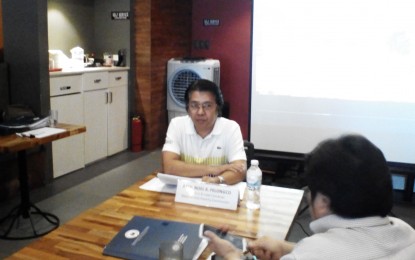
ANTI-POVERTY CZAR. National Anti-Poverty Commission (NAPC) Secretary and lead convenor Atty. Noel Felongco talks about the government's programs that would eventually drop the poverty incidence in the country to 14 percent in 2022, during a press conference in Cebu on Tuesday, March 5, 2019. (Photo by Luel Galarpe)
CEBU CITY – The National Anti-Poverty Commission (NAPC) has expressed confidence the poverty incidence in the Philippines would drop to 14 percent in 2022 once government services are brought closer to the 14 basic sectors of society with no letup.
Anti-Poverty Secretary Noel Felongco said Tuesday the NAPC has figured out a formula that combines social reform agenda and poverty reduction activities that would eventually whittle down the country’s poverty rate to 14 percent from the current 21.6 percent.
“The ultimate goal of NAPC is to realize the target of President Rodrigo Duterte to reduce the country’s poverty incidence to 14 percent in 2022, which is equivalent to about 6-8 million Filipinos to be lifted out from poverty, and to attain zero poverty by 2040,” Felongco said in a press conference held as the Master Po restaurant.
The formula, he said, is embodied in the five-year “Sambayanihan Serbisyong Sambayan” (SSS) program, which is one of the three banner programs devised by NAPC to alleviate and reduce poverty in the country.
The SSS program aimed to provide informal settler families (ISF) and the urban poor with basic services and access to climate-responsive dwelling, livelihood and employment; develop innovative infrastructure and financing mechanisms to the rural poor; strengthen rural-urban agro-economic value chains; secure the health and general well-being of poor communities; enhance food security and the Mindanao Special Development Program.
“We created the SSS because most of us have forgotten the spirit of ‘bayanihan.’ We need to bring back the culture of helping each other to alleviate the living conditions of the poorest in the country,” Felongco said.
The other two programs are the creation and roll out of the Provincial Consultative Body (PCB) and the Actionable Development Agenda for Poverty Transformation, or ADAPT 40/10/10.
The PCB is a convergent consultative mechanism at the provincial level that serves as an avenue for collaboration and coordination between government agencies, primarily the local government units (LGU) and the communities.
The PCB will also mainstream the participation of people and civil society organizations in recommending, implementing and monitoring anti-poverty programs and services.
The ADAPT 40/10/10 program, on the other hand, is aimed at helping poor communities across the country to adapt to the effects of climate change, which has altered not just the natural but also the social climate in the country.
Felongco said the 40/10/10 denotes a list of 40 poorest provinces, 10 poorest municipalities per province, and 10 poorest barangays per municipality as determined based on poverty incidence and magnitude.
With the reduction of poverty as the ultimate goal, these programs are intended to engage the participation of the 14 basic sectors -- urban poor, indigenous people, farmers, fisherfolk, formal labor and migrant workers, informal workers, women, persons with disabilities, victims of disasters and calamities, children, youth and students, senior citizens, non-governmental organizations, and cooperatives -- in the country’s 40 poverty-stricken provinces.
“This is on instruction of President Duterte himself. We shall go to all provinces without exception to engage the participation of all 14 basic sectors that make up the majority of Philippine society,” Felongco said, adding that the Sambayanihan or convergence approach will not leave out any province.
The approach is meant to capacitate or show to the basic sectors how to engage government services in addressing the 10 basic needs, including food, water, shelter, work, health care, education, social protection, healthy environment, peace, and participation in decision-making.
“The Duterte Administration may look harsh against corruption and illegal drugs, but it has the concerns of the poor at heart, hence this continuing social reform program and poverty reduction activities,” Felongco said.
He also urged LGUs nationwide, especially those in the top 40 poorest provinces, to draw up their local climate change action plan (LCCAP) to stave off widespread devastation, similar to what happened in the Bicol Region during Typhoon Usman.
The NAPC secretary said the agency is very much willing to assist the LGUs in the formulation of their own LCCAPs as this is part of the ADAPT 40/10/10 program.
The Top 40 poorest provinces in the country, which were also identified as the most vulnerable to climate change are Lanao del Sur, Maguindanao, Northern Samar, Saranggani, Sulu, Bukidnon, Siquijor, Zamboanga del Norte, Sultan Kudarat, Agusan del Sur, Western Samar, Eastern Samar, Masbate, Negros Oriental, Lanao del Norte, Catanduanes, North Cotabato, Sorsogon, Occidental Mindoro, Surigao del Sur, Mt. Province, Southern Leyte, Basilan, Misamis Occidental, Romblon, Camarines Norte, Apayao, Agusan del Norte, Kalinga, Surigao del Norte, Camiguin, Davao del Norte, Ifugao, Zamboanga Sibugay, Cotabato, Leyte, Davao Oriental, Negros Occidental, Abra, and Camarines Sur.
The NAPC, chaired by President Duterte himself with Felongco as lead convenor, is the social reform and poverty alleviation arm of the government. (PNA)
